Hummingbirds are some of nature’s most amazing birds. They are tiny and have beautiful, bright colours that grab our attention. However, many hummingbird behaviours are not well-known to people who just watch them now and then.
In this blog post, I will discuss 25 hummingbird behaviours that shed light on these lively little birds. You’ll learn about how they defend their territory and undertake incredible long-distance travels.
After reading this post, you’ll have a much better understanding of the fascinating lives of hummingbirds.
Related post to read about Best Hummingbird Feeders.

1. How Hummingbirds Hovering Allows Them to Feed While Staying Suspended Mid-Air
Hummingbirds have the unique ability to hover in mid-air by rapidly flapping their wings in a figure-eight pattern. This allows them to stay suspended while feeding on nectar from flowers, a huge advantage compared to other birds.
Their specialised flight muscles and aerodynamic wings let them beat their wings up to 70 times per second to generate the lift required for precise hovering.
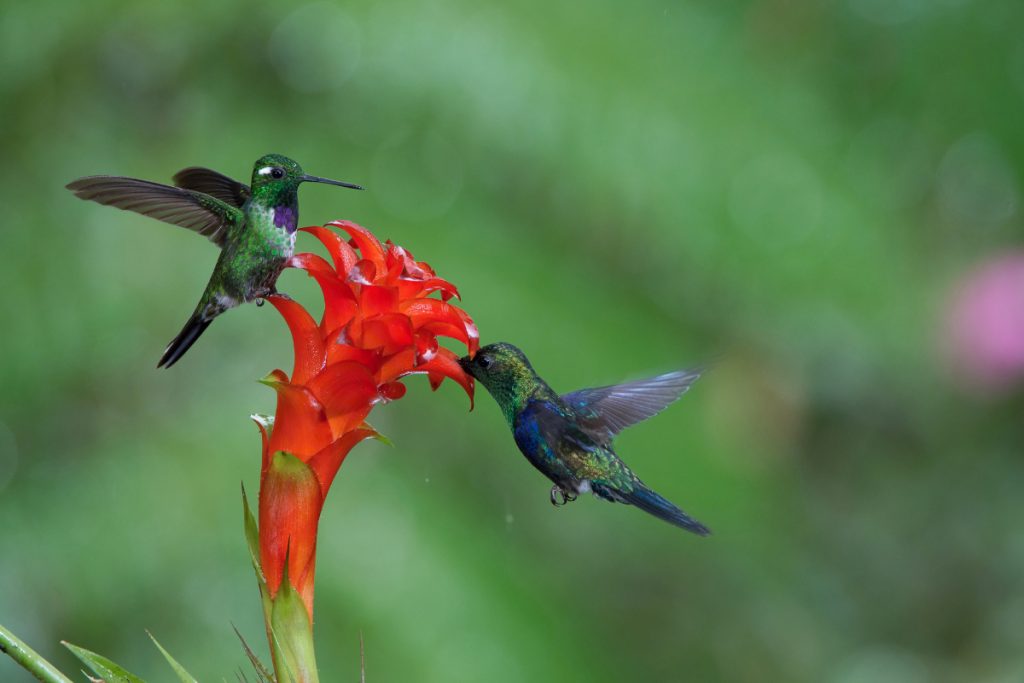
2. Nectar Feeding is Their Primarily Food Source
Hummingbirds have slender, elongated beaks and forked tongues that are perfectly adapted for accessing and lapping up flower nectar. Nectar provides the high-energy carbohydrates these fast-moving birds need.
Their tongue has a tube-like structure with fringed tips that soak up nectar. Hummingbirds can lap nectar at an incredible rate, over 10 licks per second!
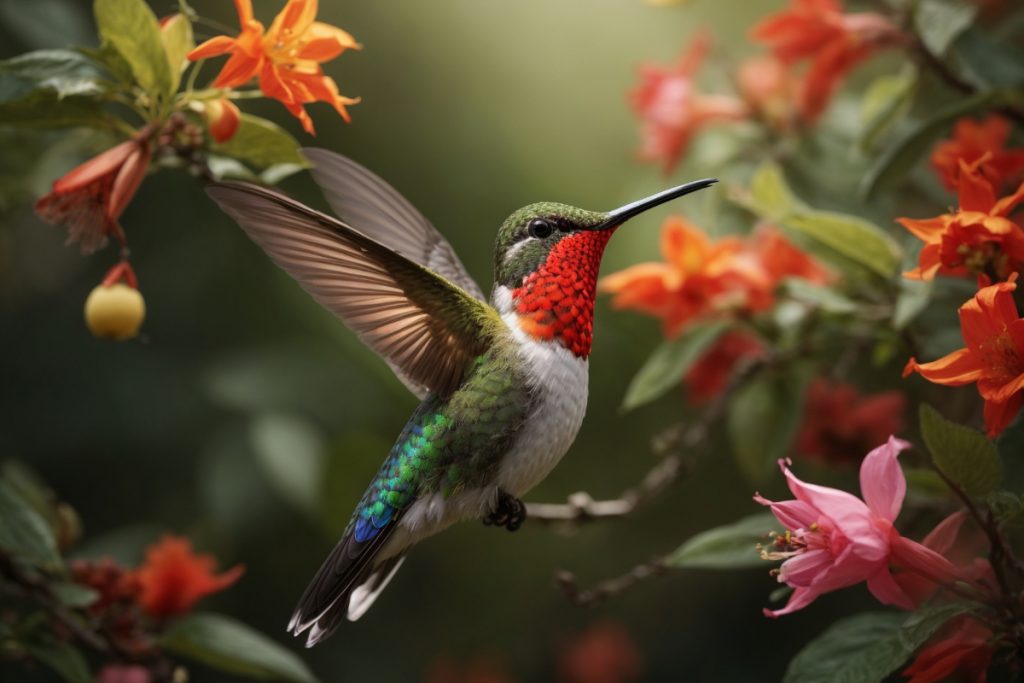
3. Darting Flight Allows Hummingbirds to Forage Efficiently and Evade Predators
In flight, hummingbirds are aerial masters capable of rapid accelerations and nimble manoeuvres. This agile darting flight enables them to efficiently move between food sources and evade predators. They can achieve swift top speeds during level flights of over 30 miles per hour. Their rapid take-offs and ability to suddenly change direction give them an edge over predators.
This is quite amazing despite their tiny size and delicate appearance. It makes me curious – how do they develop such superb flying skills and control?
I’d love to get inside a hummingbird’s mind and experience the world from their perspective to truly appreciate the intricacy of guiding those lightning-fast movements.
Their aerial dexterity must require incredibly complex coordination and reflexes. Darting from flower to flower and harvesting nectar seems like an exciting rollercoaster ride!
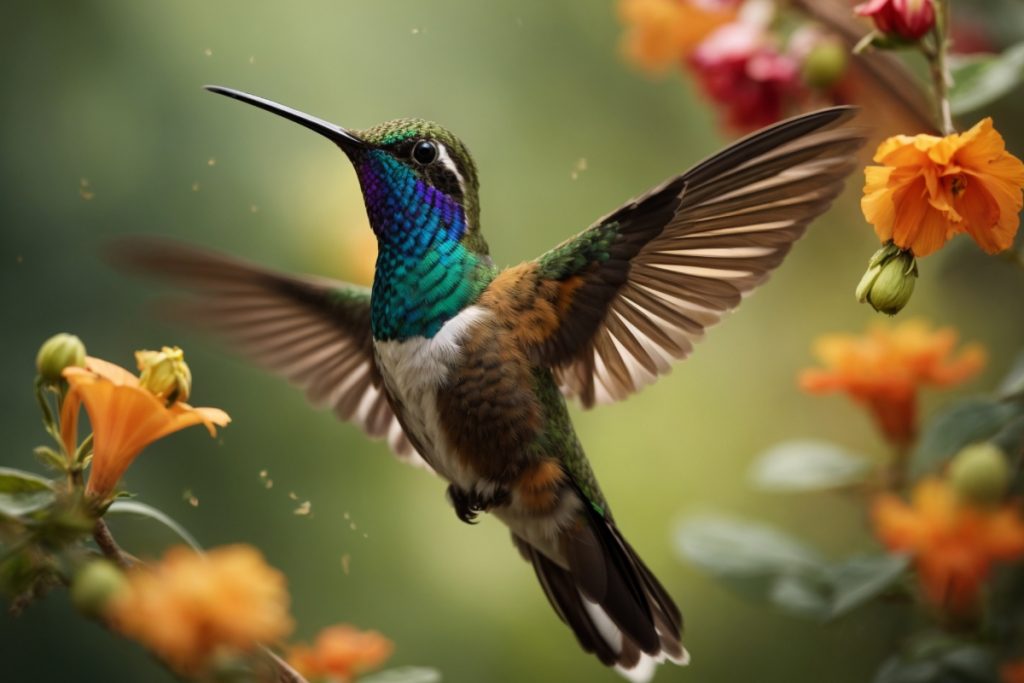
4. Hummingbirds Employ Torpor as an Energy-Saving Technique in Challenging Conditions
To save energy when food is limited, or temperatures drop, hummingbirds can enter a hibernation-like state known as torpor. Their metabolic rate slows down tremendously, reducing their energy needs.
Breathing, heart rate and body temperature all decrease substantially. Torpor allows hummingbirds to survive periods of cold weather or food scarcity as they conserve their precious energy reserves.

5. Frequent Perching Allows Hummingbirds to Rest Between Feeding Bouts
While hummingbirds seem constantly in motion, they do spend much of their time perching. Watch for them resting atop slender branches, using their clawed feet to grasp surfaces.
Perching allows them to conserve energy between rapid feeding bouts. They regulate their exertion by alternating intense activity with frequent rest.

6. Hummingbirds Open Their Beaks to Perform Various Functions
Hummingbirds open their slender beaks for several important reasons:
- Feeding: They open their beaks wide to snatch small insects and spiders out of the air to supplement their nectar diet with protein. Beak opening allows them to capture flying prey.
- Thermoregulation: On hot days, hummingbirds open their beaks wide to pant. This evaporative cooling by rapid breathing dissipates excess heat. It’s similar to a dog panting to cool down.
- Communication: Hummingbirds open their beaks when making various vocalisations like chirps, trills and buzzing. The open beak helps shape and amplify their diverse sounds.
- Aggression: During territorial disputes or conflicts over feeders, hummingbirds will open their beaks wide as a threatening display to rivals. This signals their readiness to defend resources.
So, in summary, hummingbirds open their specialised beaks for feeding on insects, thermoregulation through panting, vocal communication and expressing aggression during territorial encounters. The flexibility of their beaks allows for multifunctional use in their daily lives.

7. Bathing Keeps Hummingbirds Cool and Clean
Hummingbirds keep cool and clean their plumage by bathing frequently. They splash in water sources such as rain collected in leaves or petals, dripping faucets, sprinklers, and bird baths.
The bathing washes away dirt, parasites and excess oils, helping maintain their feathers in peak condition.
Bathing also helps these little birds stay nimble for their aerial acrobatics. When their feathers are clean, they can zip through the air more easily, making sure they’re always ready for their next flower visit or to dart away from any trouble.
It’s like having a quick shower gives them a fresh burst of energy!

8. Hummingbirds Engage in Diligent Feather Maintenance for Optimal Flight
Hummingbirds have specially adapted feathers that enable their unique flight abilities. They spend significant time preening and grooming their feathers to ensure they can fly efficiently.
Using their slender beak, they methodically realign any ruffled feathers and distribute antioxidants and oils for maximum aerodynamic performance.
Proper feather maintenance is critical as it helps them zip through the air with ease. With each feather smoothed, they can fly quickly without a hitch.
It’s like they are making sure their tiny wings are in top shape, ready to take on the world every day.

9. They Exhibit Fierce Territorial Behaviour for Steady Food Access
Don’t underestimate these tiny birds – male hummingbirds fiercely defend their feeding territories, chasing away intruders even if they are much larger.
Their possessive behaviour ensures they have a reliable, plentiful source of nectar to meet their high metabolic demands. Failure to defend a prime territory can be life-threatening because, without enough food, they wouldn’t have the energy to fly.
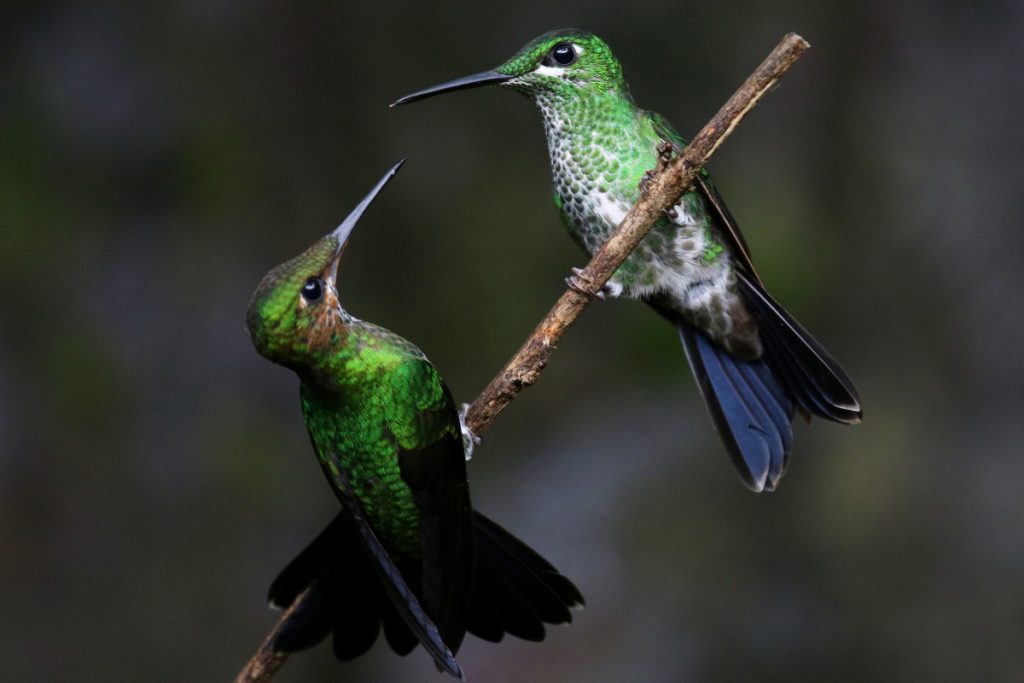
10. Hummingbirds Display Courtship to Attract the Attention of Female Hummingbirds
When it’s time to attract a mate, male hummingbirds perform elaborate courtship rituals or, preferably, courtship displays.
They soar skyward, sometimes to impressive heights, and then swoop down in a high-speed dive that’s sure to catch the eye of any female hummingbirds watching. As they dive, their tail feathers often make a distinctive trilling noise, like nature’s own love song, designed to charm potential partners.
It’s a remarkable aerial performance that combines skill, speed, and sound, all in the name of romance!
These can be amazingly breathtaking shows to capture a female’s interest!
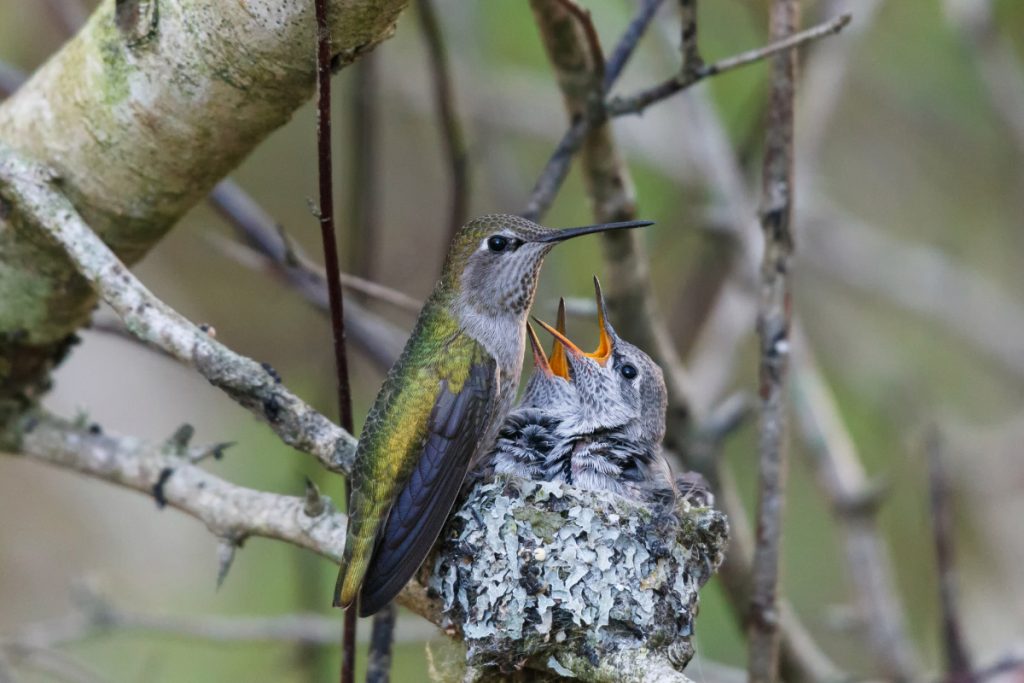
11. Hummingbirds Build Nests to Safeguard Their Chicks
Female hummingbirds carefully construct tiny, compact nests to house their chicks using plant down, moss, lichen, and even spider silk. The stretchy spider webs allow the nest to expand as the young birds grow.
The females are solely responsible for building a durable, protected nest in preparation for raising their offspring.
These clever mums pick just the right spot, usually on a gently swaying branch, which keeps the eggs safe from any prying predators. It’s a bit like them weaving a cosy little cradle, making sure it’s strong enough to last through wind and rain.
They work tirelessly, using nature’s own bits and bobs to make a snug home where their tiny chicks can flourish.
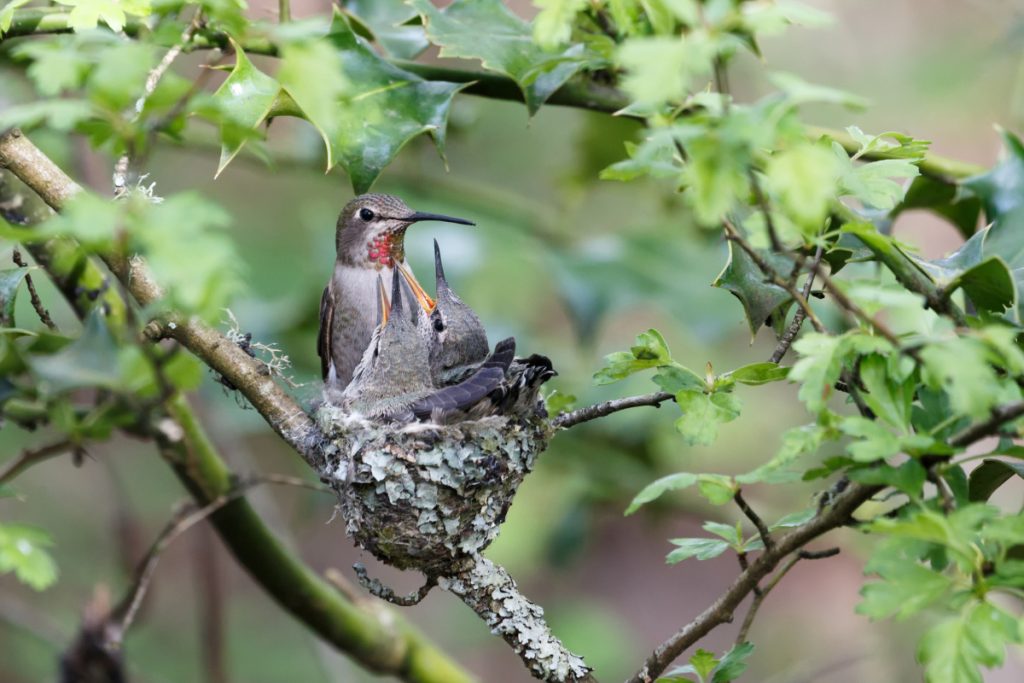
12. Hummingbirds Forage to Feed Their Chicks Directly
After eggs hatch, the female hummingbird is entirely responsible for providing for her chicks. She forages tirelessly, collecting nutritious nectar and plucking small insects and spiders to feed her fast-growing brood.
Unlike many bird species, hummingbird mothers directly feed their nestlings rather than regurgitating food.
This hard-working mum zips back and forth, almost like a tiny superhero, making sure her little ones get all the fresh grub they need to get big and strong. With a beak as a precision tool, she picks out the best bits for her babies so they’re getting top-notch meals every time.
It’s like a full-time job, but this dedicated female hummingbird is up to the task, making sure her fluffy chicks won’t go hungry for a minute.
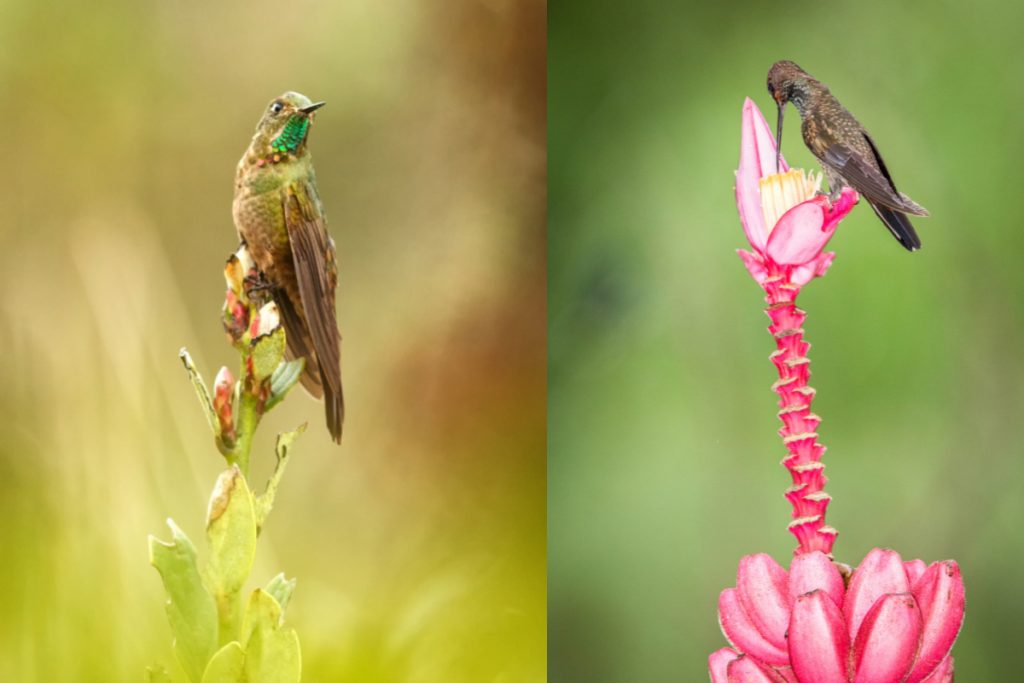
13. Hummingbirds Migrate to Exploit Seasonal Habitat Advantages
The annual migration of hummingbirds is a testament to their resilience and the natural cycle of seeking out the most favourable conditions. Here is a peek into their migratory habits:
- Seasonal Explorers: Species like the ruby-throated hummingbird embark on extensive migrations to take advantage of the best seasonal habitats.
- Timed Travels: Their migrations are timed with the seasons – heading north to breed in the spring and south to find warmth as winter approaches.
- Long-Distance Journeys: These tiny birds travel thousands of miles each year, a remarkable distance for birds of their size.
- The Gulf Crossing: They undertake a gruelling, non-stop flight across the Gulf of Mexico, showcasing their incredible stamina.
- Adaptive Strategies: Migration is essential for accessing abundant food sources and optimal breeding sites, demonstrating a sophisticated adaptation to seasonal changes.
This is quite amazing when you think about it, isn’t it? It’s as if they’ve got the whole journey mapped out in their tiny heads, knowing exactly where and when to go every season.
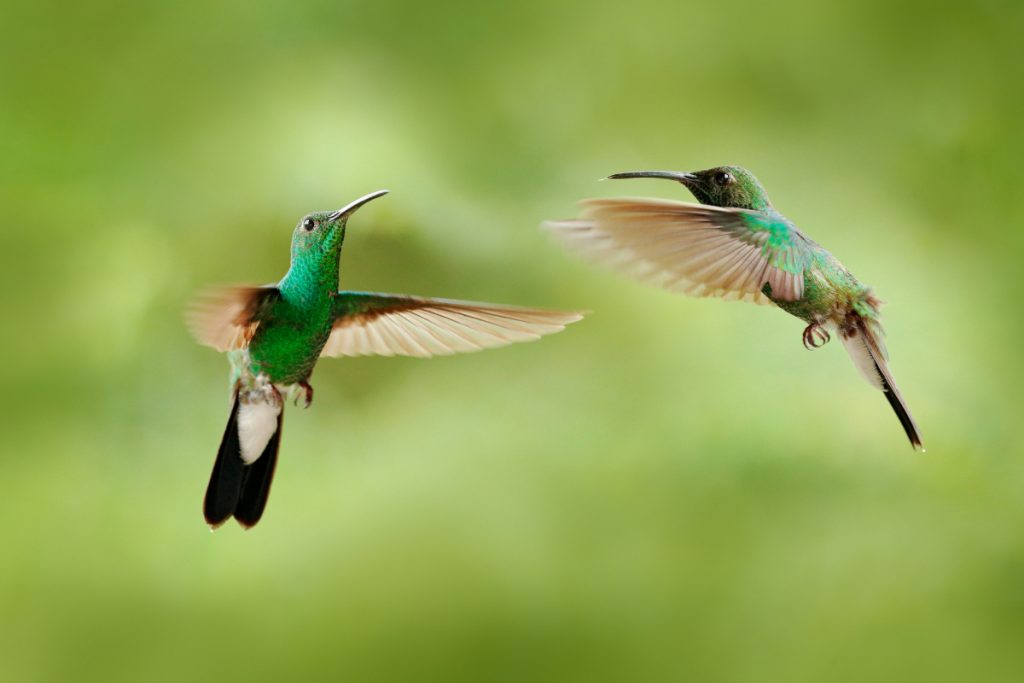
14. Hummingbirds Use Bills as Dueling Weapons in Battles Over Territories and Mates
When it comes to defending their patch or winning over a mate, male hummingbirds don’t shy away from a bit of argy-bargy. They might be tiny, but their courage is huge! Their bills, sharp as needles, aren’t just for sipping nectar; they’re handy in a tiff with rivals, too.
Imagine them as the fencers of the bird world, darting and dodging in mid-air, showing off their moves to keep other chaps away from their favourite flower spots and impress the ladies.
But it’s not all about the rough and tumble; a lot of the time, it’s the show that counts. A high-speed chase or a flashy fly-by is often enough to sort things out. And after the ladies have chosen the best of the bunch, you won’t find the gents chasing them off.
Nope, those female hummingbirds are free to flit about, visiting different territories, maybe even sparking a little more competition among the boys. It’s all part of the hummingbird hustle!

15. Hummingbirds Fan Tails for Messages and Intimidation
Watch for males fanning or flaring their iridescent tail feathers during conflicts or courtship. This eye-catching display makes them appear larger and more formidable to rivals or potential mates. The shimmering fan captures attention as they strut their stuff.
It’s a real show-stopper, this tail fanning. When the sunlight hits just right, those tail feathers glitter like precious stones. It’s all about making the biggest, flashiest statement, whether they’re warning a rival or charming a female with their brilliance.
And it works a treat, too – it’s hard not to stare when they’ve got their tail feathers spread out like a dazzling fan at a grand event.

16. Hummingbirds Click Their Wings to Signal Without Song
In addition to vocalisations, hummingbirds also produce non-vocal sounds by forcefully clipping their wings together.
These wing clicks communicate territorial claims during conflicts or serve to attract females during courtship displays. The unique sound transmits beyond their vocal range.
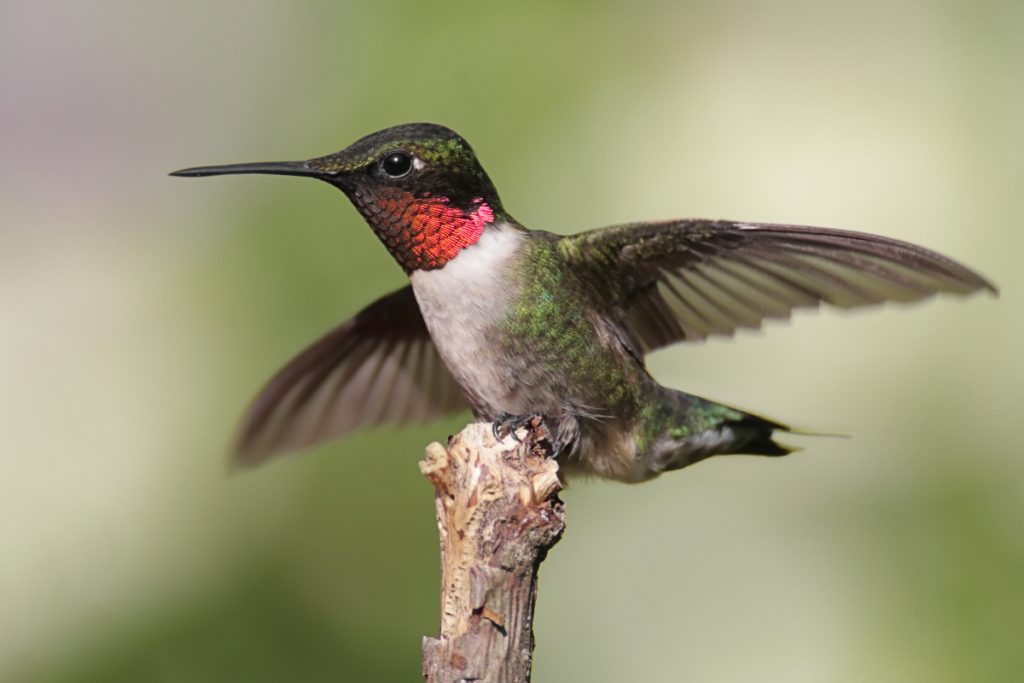
17. Hummingbirds Shuffle Their Feet for Better Balance
Hummingbirds have an incredible ability to hover and dart precisely in any direction when feeding. As they crane their flexible neck to target flowers, they constantly shuffle and adjust their small clawed feet to maintain balance. The active foot movements provide stability for feeding mobility.
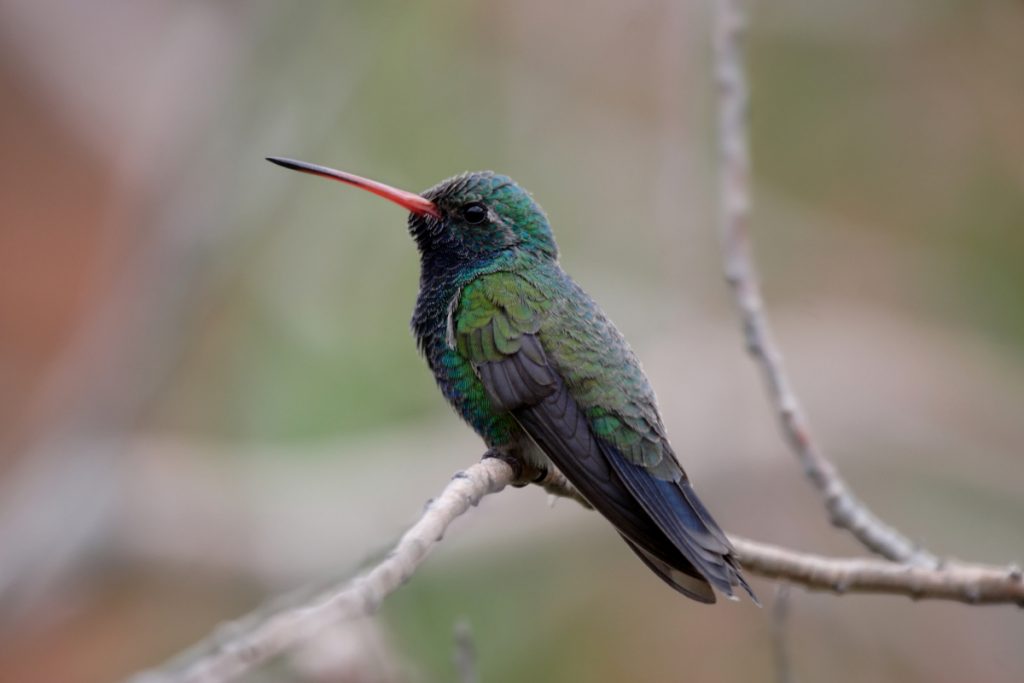
18. Hummingbirds Pant to Cool Down
On hot days, hummingbirds will pant to help shed excess heat, much like dogs. As they take rapid, shallow breaths, evaporative cooling from their moist mouth and throat dissipates heat and brings down their body temperature.
Panting may look like they are breathing heavily after a vigorous chase, but it is a strategy for cooling.
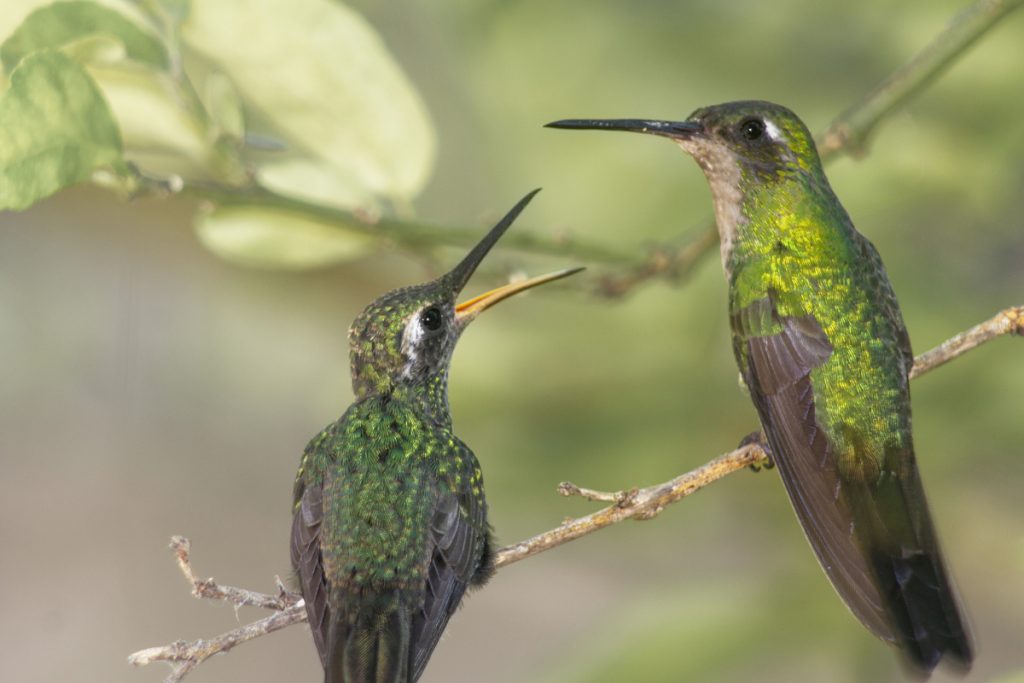
19. Hummingbirds Communicate Through Varied Vocalizations
Hummingbirds may be more on the quiet side compared to songbirds, but they still have their own unique set of sounds for getting their messages across.
Here are some of the types of chirps and buzzes these tiny birds use:
- Chirps for Territory: To let others know “This spot’s taken,” they have a series of chirps that serve as keep-out signs for their feeding zones.
- Courtship Calls: When it’s time to impress, male hummingbirds break out a mix of chirps and other unique sounds, sometimes accompanied by a feather-made symphony during their aerial dance.
- Chick Chat: Soft sounds from mum tell the little ones it’s dinner time, although the kids are often the louder ones, begging away.
- Alarm Alerts: Their sharp calls can signal “Danger!” alerting others to the presence of predators or unwelcome visitors.
These sounds, while not as varied as those of some birds, are key to the daily lives of hummingbirds, helping them navigate their world.
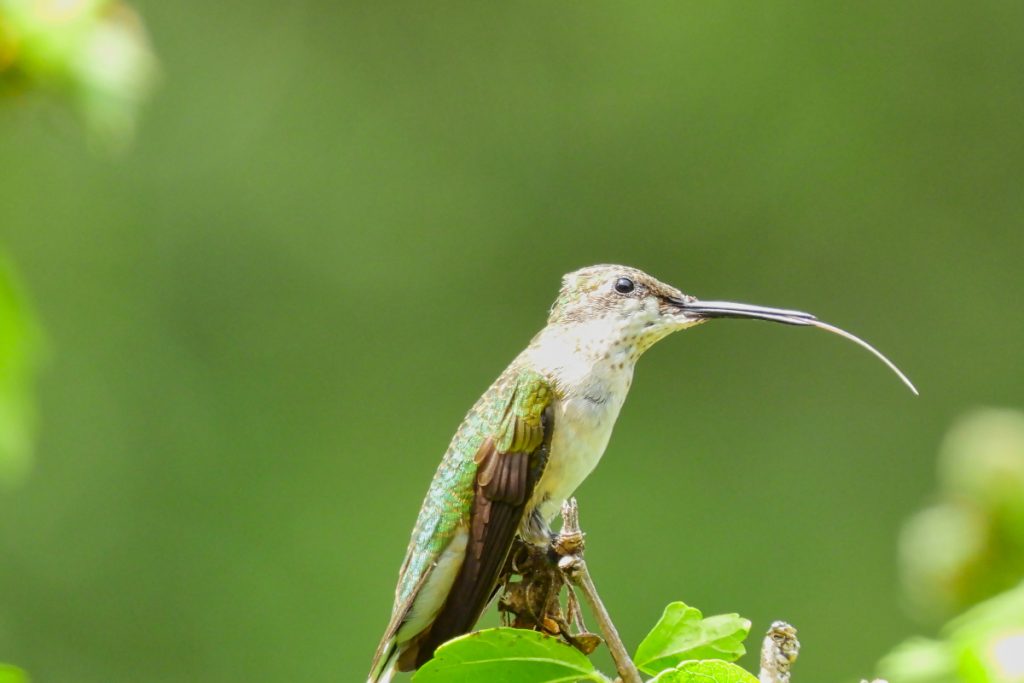
20. Hummingbirds Wipe Their Bills to Maintain Cleanliness
After feeding, you’ll see hummingbirds wipe their bill against a branch in a wiping motion. Using their tongue, they transfer sticky nectar droplets to the edge of their bill.
The wiping action removes this excess nectar and keeps their bill clean for efficient ongoing feeding. A neat trick for keeping their instrument tip-top!
Related post to read: Do Hummingbirds Eat Bees?

21. Leaf Baths Supplement Water Bathing
In addition to bathing in water, hummingbirds also splash against and flutter through wet foliage after rainfall or heavy dew.
This dislodges dirt and allows them to work the water into their plumage, much like when humans shower. Leaf bathing cleans places they can’t reach by water bathing alone.

22. Spiderwebs: A Hummingbird’s Nesting Tool
Hummingbird nest builders will intentionally gather strands of spider silk from webs as they fly by. These stretchy silk threads allow the nest to expand flexibly to accommodate the growing hatchlings.
Spider silk is a crucial construction material female hummingbirds actively collect for anchoring and developing their nest architecture.
Related post to read: Do Hummingbirds Eat Wasps?
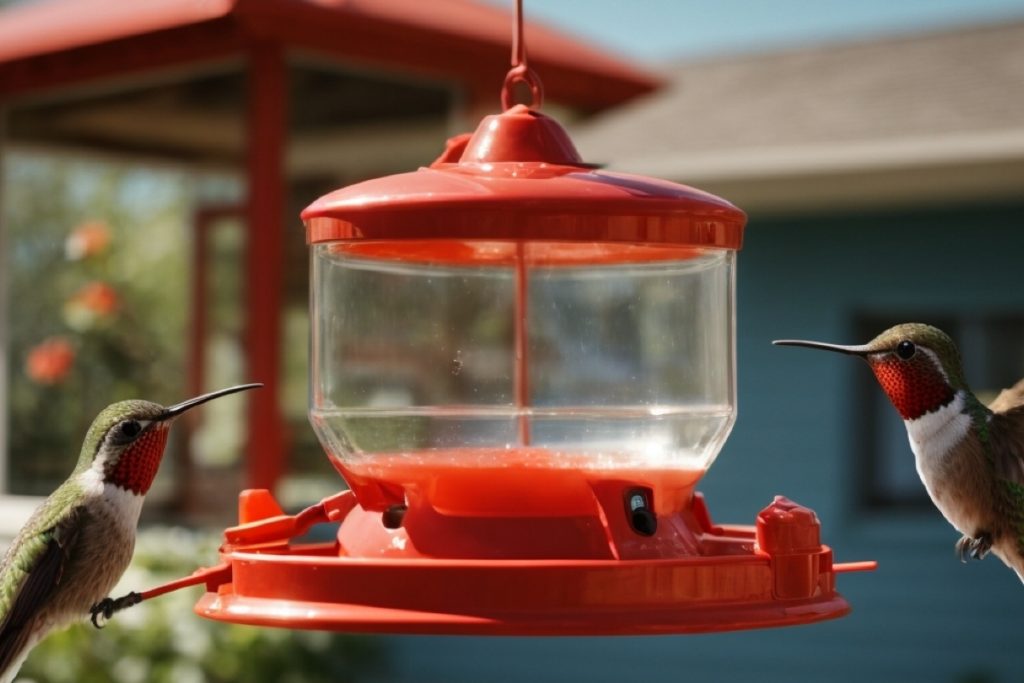
23. Hummingbird Chasing: A Critical Practice for Survival Skills
While it might look like hummingbirds are just having a bit of fun when they chase each other, there’s a lot more going on beneath the surface.
Here are some key points:
- Territorial Defense: These chases are often about protecting their turf, ensuring they keep the best spots for feeding and impressing potential mates to themselves.
- Skill Refinement: Darting through the air at breakneck speeds boosts their agility and teaches them to react quickly, which is a vital skill for outmanoeuvring predators and rivals.
- Competitive Edge: The cut and thrust of a good chase help them practice outsmarting other hummingbirds, which is crucial when food is scarce and competition is fierce.
Each twist and turn in the air is more than just a game for these birds; it’s about staying sharp and staying alive.

24. Hummingbirds Use Leap Launches for Swift Takeoffs
On takeoff from perches, hummingbirds jump upwards forcefully with their feet to give themselves an extra burst before rapidly flapping their wings.
The hindlimb push creates momentum to get them airborne faster. This leap launch helps them initiate flight quickly to evade threats.
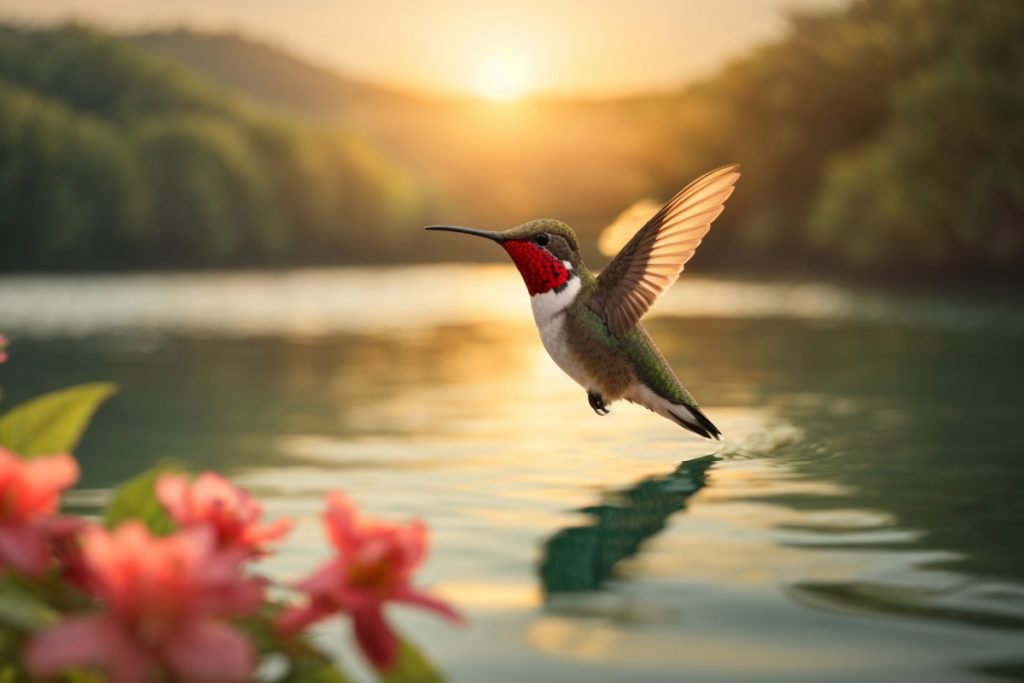
25. Hummingbirds Sunbathe to Maintain Feathers and Manage Parasites
Don’t be surprised to spot a hummingbird perched in a sunny spot with its wings spread wide. While they’re soaking up the rays, it’s not just for relaxation.
- The warmth from the sun is thought to help control feather mites and other parasites that can impede their flight performance.
- Additionally, basking in the sun helps these little birds with their preening process. The heat makes the oil from their preen gland more spreadable, which is essential for keeping their feathers in top condition.
So, when hummingbirds are basking in the sunlight, they’re not just enjoying the warmth; they’re also taking care of their feathers, ensuring they stay swift and sleek for flying.
Final Thought
As you can see, hummingbirds have an impressive repertoire of behaviors, allowing them to survive and thrive. We are only beginning to uncover the secrets of their private lives.
I hope this glimpse into the world of hummingbird behaviors will give you a new appreciation for these tiny, beautiful birds!
Now, over to you: what are your favourite hummingbird behaviours? Please feel free to share your experiences in the comment section below.
As always, let me know your thoughts on this. And until next time, thanks for stopping by, and happy bird watching.
Useful Links:
Related Posts to Read:
- Do Hummingbirds Beaks Open When Feeding?
- The Mysteries of Hummingbird Flight.
- 6 Fascinating Facts About Hummingbird Sizes.
- Ruby-Throated Hummingbird Migration Map.
- Where Do Hummingbirds Go When It Rains?
- How Much Does A Hummingbird Eat Per Day?
- Hummingbird Diet and Nutrition
References:
- About Hummingbird (Link).
- Greenewalt, C. H. (1960). Hummingbirds. New York: Doubleday. Google Scholar.
- Carey C. The impacts of climate change on the annual cycles of birds. Philos Trans R Soc Lond B Biol Sci. 2009 Nov 27; 364(1534):3321-30. doi: 10.1098/rstb.2009.0182. PMID: 19833644; PMCID: PMC2781852.
- Rico-Guevara A, Rubega MA, Hurme KJ, Dudley R. Shifting Paradigms in the Mechanics of Nectar Extraction and Hummingbird Bill Morphology. Integr Org Biol. 2019 Jan 2;1(1):oby006. doi: 10.1093/iob/oby006. PMID: 33791513; PMCID: PMC7671138.
- Tyrrell LP, Goller B, Moore BA, Altshuler DL, Fernández-Juricic E. The Orientation of Visual Space from the Perspective of Hummingbirds. Front Neurosci. 2018 Jan 30;12:16. doi: 10.3389/fnins.2018.00016. PMID: 29440985; PMCID: PMC5797624.
- Hummingbirds Sighting (Journey North Map).
- About Hummingbird’s Characteristics.
